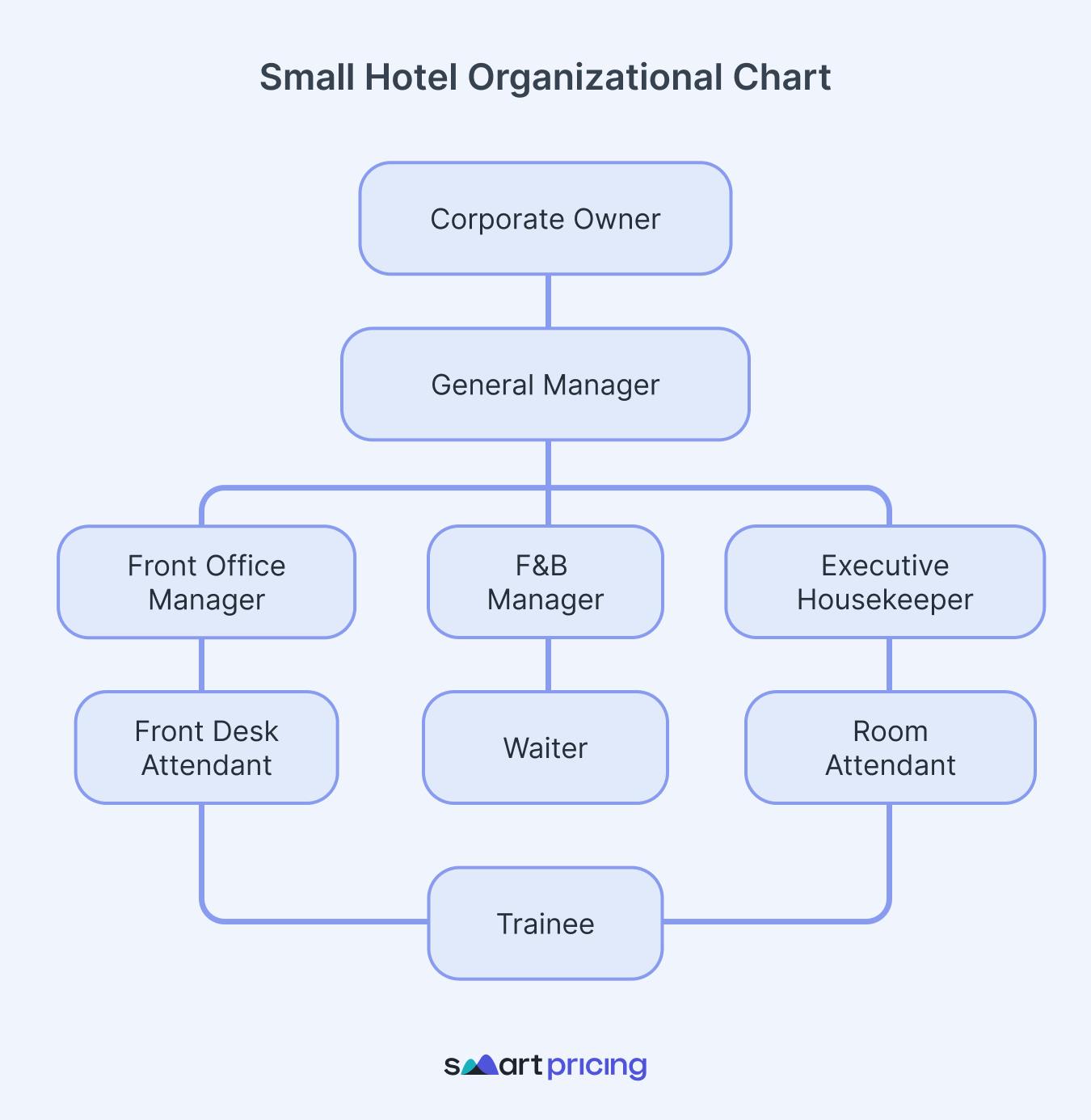Do you want to focus on what really matters in your hotel? What you need is an organizational chart
An organizational chart helps you define your staff's responsibilities and delegate tasks. In this article we explain how to create one.

Have you ever thought about where small hotels differ from large hotel chains?
Beyond turnover, number of rooms and number of employees, a large hotel chain has a very structured organization, starting with its organizational chart.
In this article we discuss the hotel organizational chart, why it is important even for a small hotel, and how to create one.
Let's start.
What is a hotel organizational chart
An organizational chart is a graphic representation of the hotel's organizational structure.
To simplify, the organizational chart is a list of all the people who work in the hotel, their roles, responsibilities, and relationships among them.
Usually the organizational chart is represented with a tree chart, however, there are different types of representation depending on one's needs.

Why should you create an organizational chart at your hotel?
The common mistake people make is to draw the organization chart, present it to the whole team, hang it on the wall like a poster and never look at it again.
The organizational chart is actually an operational tool to be constantly updated and referred to when issues arise.
But in concrete terms, what purpose does an organizational chart serve?
Why is it so important?
Because the organization chart clearly defines the responsibilities of staff members.
It also makes sure that this responsibility is shared between everyone.
That way, whenever a problem arises, whether it is the need for maintenance in a room, a no-show, a guest complaint, everyone knows immediately who to contact.
Instead, would everyone turn to the hotelier or the manager, it would generate confusion and waste time.
The result is that you, the hotelier, would be spending your days chasing problems without ever doing really productive work for your establishment.
With an organizational chart you can define the responsibilities of different roles, free yourself from tasks you can delegate, and devote yourself to the activities that make your hotel grow.
How to create a hotel's organizational chart
To build the organizational chart, start by making a list of all the people who work at the facility.
In the organizational chart, it is important to define what are operational roles (front desk staff, kitchen, dining room) and support roles, that is, those that help the whole business and not just one department (administration, human resources, maintenance).
In small hotels, it often happens that the support staff is a third party person or company.
So add outside maintainers, labor consultants, HACCP managers, etc. to your organizational chart.
Once you have a complete list it is time to define responsibilities and the relationships between roles.
When you define responsibility, you are deciding, in effect, what a certain person is in charge of.
While some responsibilities are obvious (the receptionist is responsible for doing check-ins), others are not so obvious (who is in charge of sending the invoice summary to the travel agents?).
That is why it is important to define the less obvious responsibilities.
It is these that are otherwise put on the shoulders of the hotelier/manager!
The next step is to define the relationships between the various roles and people.
You can do this activity simply by drawing lines between the various staff members and the immediate supervisors.
Or you can indicate relationships that are also common and not directly in the line of responsibility.
In this case you will have to define in which cases that specific line of communication should be adopted.
For example, you may decide that for problems with credit card collections, front desk members can go directly to the administrative manager bypassing the front office manager.
What roles should be included in the hotel's organizational chart?
As mentioned earlier, we suggest that you also include external workers directly involved in the operations of the hotel in the organizational chart.
Why include all the roles?
Because this way everyone knows the "rules of engagement" and who to contact in any eventuality.
In addition, an important psychological aspect must be considered.
Not seeing one's role in the organizational chart can lead people to think that their work is not recognized by the company, resulting in a lack of interest in the hotel and its guests.
Why include outsiders as well?
Because it helps both staff members and the third-party partners themselves understand what relationships and contacts need to be involved in each activity.
For example, a maintenance person might be contacted by the front desk, operate independently, and send the invoice directly to the administration.
Or a supplier might receive an order placed by the kitchen staff, deliver the goods to the kitchen, and send the invoice to the administration.
The organizational chart is a very powerful tool because it helps you delegate responsibilities to your staff and free you from operational tasks.
With it, you can focus on more value-added activities, such as business development, sales, and building a high-value staff.
Another tool that can save you time is Smartpricing!
Smartpricing is the dynamic pricing and revenue management software that helps you find the best rates for your rooms while saving you valuable time.
Find out now if Smartpricing is right for you!
